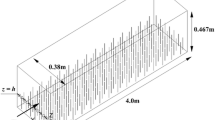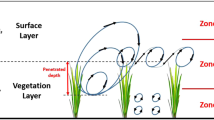Abstract
The flow conditions in and around a suspended canopy, resembling those formed by aquaculture structures such as rafts cages and longlines, were modeled using an augmented version of the hydrodynamic model Environmental Fluid Dynamics Code. The model was calibrated using vertical profiles of horizontal velocities, Reynolds stresses, and turbulent kinetic energies obtained from prior laboratory flume experiments. The parameter estimation code, PEST, was used to optimize various model parameters including horizontal momentum diffusivity, vertical eddy viscosity, turbulence closure constants, and, most importantly, depth-dependent drag coefficients. An increasing average drag coefficient was observed with decreasing canopy blockage ratio, and an empirical relationship for the vertical variation of drag coefficient was developed that may be appropriate for use in full-scale models of aquaculture systems. Overall, the calibrated canopy-turbulence parameters and drag-coefficient empiricisms may yield improved predictions of alterations to hydrodynamic and nutrient-transport conditions due to various aquaculture structures. Such predictions will help develop methods to minimize environmental impacts and to increase production from aquaculture farms.








Similar content being viewed by others
References
Blanco J, Zapata M, Moroño Á (1996) Some aspects of the water flow through mussel rafts. Sci Marina 60(2–3):275–282
Blumberg AF, Mellor GL (2013) A description of a three-dimensional coastal ocean circulation model. In: Heaps NS (ed) Three-dimensional coastal ocean models. American Geophysical Union, Washington. https://doi.org/10.1029/CO004p0001
Boyd AJ, Heasman KG (1998) Shellfish mariculture in the Benguela system: water flow patterns within a mussel farm in Saldanha Bay, South Africa. J Shellfish Res 17(1):25–32
Dunn C, Lopez F, Garcia M (1996) Mean flow and turbulence in a laboratory channel with simulated vegetation. Technical report, Department of Civil Engineering, University of Illinois at Urbana-Champaign
Galperin B, Kantha LH, Hassid S, Rosati A (1988) A quasi-equilibrium turbulent energy model for geophysical flows. Journal of the Atmospheric Sciences 45(1):55–62. https://doi.org/10.1175/1520-0469(1988)045<0055:AQETEM>2.0.CO;2
Ghisalberti M, Nepf HM (2004) The limited growth of vegetated shear layers. Water Resour Res 40(7):1–12
Gibbs MM, James MR, Pickmere SE, Woods PH, Shakespeare BS, Hickman HW, Illingworth J (1991) Hydrodynamic and water column properties at six stations associated with mussel farming in Pelorus Sound. N Z J Mar Freshw Res 25(3):239–254
Grant J, Bacher C (2001) A numerical model of flow modification induced by suspended aquaculture in a Chinese bay. Can J Fisher Aquat Sci 58:1003–1011
Hamrick J (1992) A three-dimensional environmental fluid dynamics computer code: theoretical and computational aspects. Technical report, Virginia Institute of Marine Science
Hamrick J (2007) The environmental fluid dynamics code: theory and computation. Technical report, US EPA, Fairfax, VA
Hamrick JM (1996) User’s manual for the environmental fluid dynamics computer code. Technical report, Virginia Institute of Marine Science
Huai W, Li C (2016) Longitudinal dispersion in open channel flow with suspended canopies. Water Sci Technol 74(3):722–728
James SC, Boriah V (2010) Modeling algae growth in an open-channel raceway. J Comput Biol 17(7):895–906
James SC, Jones CA, Grace MD, Roberts JD (2010) Advances in sediment transport modelling. J Hydraul Res 48(6):754–763
James SC, O’Donncha F, Plew DR (2016) Calibration of a 3D hydrodynamic aquaculture model. OCEANS’16. Monterey, California, pp 1–7
James SC, Johnson EL, Barco J, Roberts JD (2017) Simulating current-energy converters: SNL-EFDC model development, verification, and parameter estimation. Renew Energy. https://doi.org/10.1016/j.renene.2017.07.020
Katul GG, Mahrt L, Poggi D, Sanz C (2004) One- and two-equation models for canopy turbulence. Bound-Layer Meteorol 113:81–109
Mellor GL, Yamada T (1982) Development of a turbulence closure model for geophysical fluid problems. Rev Geophys 20(4):851–875
Naot D, Nezu I, Nakagawa H (1996) Hydrodynamic behaviour of partly vegetated open channels. J Hydraul Eng 122(11):625–633
Nepf HM (1999) Drag, turbulence and diffusion in flow through emergent vegetation. Water Resour Res 35(2):479–489
Nepf HM, Vivoni ER (2000) Flow structure in depth-limited, vegetated flow. J Geophys Res 105(C12):28,547–28,557
Newell CR, Richardson J (2014) The effects of ambient and aquaculture structure hydrodynamics on the food supply and demand of mussel rafts. J Shellfish Res 33(1):257–272
O’Donncha F, Hartnett M, Nash S (2013) Physical and numerical investigation of the hydrodynamic implications of aquaculture farms. Aquac Eng 52:14–26. https://doi.org/10.1016/j.aquaeng.2012.07.006
O’Donncha F, Ragnoli E, Suits F (2014) Parallelisation study of a three-dimensional environmental flow model. Comput Geosci 64:96–103
O’Donncha F, Hartnett M, Nash S, Ren L, Ragnoli E (2015a) Characterizing observed circulation patterns within a bay using HF radar and numerical model simulations. J Mar Syst 142:96–110
O’Donncha F, Hartnett M, Plew DR (2015) Parameterizing suspended canopy effects in a three-dimensional hydrodynamic model. J Hydraul Res 53(6):714–727. https://doi.org/10.1080/00221686.2015.1093036
O’Donncha F, James SC, O’Brien N, Ragnoli E (2015c) Parallelisation of hydro-environmental model for simulating marine current devices. In: OCEANS’15, Washington, DC, pp 1–7
O’Donncha F, Ragnoli E, Venugopal S, James SC, Katrinis K (2016) On the efficiency of executing hydro-environmental models on Cloud. Procedia Eng 154:199–206. https://doi.org/10.1016/j.proeng.2016.07.447
O’Donncha F, Venugopal S, James SC, Ragnoli E (2016b) Deploying and optimizing performance of a 3D hydrodynamic model on Cloud. In: OCEANS’16. Monterey, California, pp 1–7
O’Donncha F, James SC, Ragnoli E (2017) Modelling study of the effects of suspended aquaculture installations on tidal stream generation in Cobscook Bay. Renew Energy 102:65–76
Panchang V, Cheng G, Newell C (1997) Modeling hydrodynamics and aquaculture waste transport in coastal Maine. Estuaries 20(1):14–41
Pilditch CA, Grant J, Bryan KR (2001) Seston supply to sea scallops (Placopecten magellanicus) in suspended culture. Can J Fish Aquat Sci 58(2):241–253
Plew DR (2011a) Depth-averaged drag coefficient for modeling flow through suspended canopies. J Hydraul Eng 137(2):234–247. https://doi.org/10.1061/(ASCE)HY.1943-7900.0000300
Plew DR (2011b) Shellfish farm-induced changes to tidal circulation in an embayment, and implications for seston depletion. Aquac Environ Interact 1:201–214
Plew DR, Stevens CL, Spigel RH, Hartstein ND (2005) Hydrodynamic implications of large offshore mussel farms. IEEE J Ocean Eng 30(1):95–108
Plew DR, Spigel RH, Stevens CL, Nokes RI, Davidson MJ (2006) Stratified flow interactions with a suspended canopy. Environ Fluid Mech 6(6):519–539
Poggi D, Porporato A, Ridolfi L, Albertson J, Katul G (2004) The effect of vegetation density on canopy sub-layer turbulence. Bound-Layer Meteorol 111(3):565–587
Qiao J, Delavan S, Nokes R, Plew D (2016) Flow structure and turbulence characteristics downstream of a spanwise suspended linear array. Environ Fluid Mech 16(5):1021–1041
Réthoré PEM, Sørensen NN, Bechmann A, Zahle F (2009) Study of the atmospheric wake turbulence of a CFD actuator disc model. In: 2009 European wind energy conference and exhibition
Shi J, Wei H, Zhao L, Yuan Y, Fang J, Zhang J (2011) A physical-biological coupled aquaculture model for a suspended aquaculture area of China. Aquaculture 318(3–4):412–424
Smagorinsky J (1963) General circulation experiments with the primitive equations, part I: the basic experiment. Mon Weather Rev 91(3):99–164
Stevens C, Plew DR, Hartstein N, Fredriksson D (2008) The physics of open-water shellfish aquaculture. Aquac Eng 38(3):145–160
Tseung HL, Kikkert GA, Plew D (2016) Hydrodynamics of suspended canopies with limited length and width. Environ Fluid Mech 16(1):145–166
Wu W, Shields FD Jr, Bennett SJ, Wang SSY (2005) A depth-averaged two-dimensional model for flow, sediment transport, and bed topography in curved channels with riparian vegetation. Water Resour Res 41(W03015):1–15
Xu TJ, Dong GH (2018) Numerical simulation of the hydrodynamic behaviour of mussel farm in currents. Ships Offshore Struct 13:835–846
Zhao F, Huai W, Li D (2017) Numerical modeling of open channel flow with suspended canopy. Adv Water Resour 105:132–143. https://doi.org/10.1016/j.advwatres.2017.05.001
Acknowledgements
Elements of this research received funding from the European Union’s Horizon 2020 research and innovation program under Grant Agreement No. 773330. The manuscript was vastly improved because of thorough critiques offered by two anonymous reviewers.
Author information
Authors and Affiliations
Corresponding author
Additional information
Publisher's Note
Springer Nature remains neutral with regard to jurisdictional claims in published maps and institutional affiliations.
Rights and permissions
About this article
Cite this article
James, S.C., O’Donncha, F. Drag coefficient parameter estimation for aquaculture systems. Environ Fluid Mech 19, 989–1003 (2019). https://doi.org/10.1007/s10652-019-09697-7
Received:
Accepted:
Published:
Issue Date:
DOI: https://doi.org/10.1007/s10652-019-09697-7




